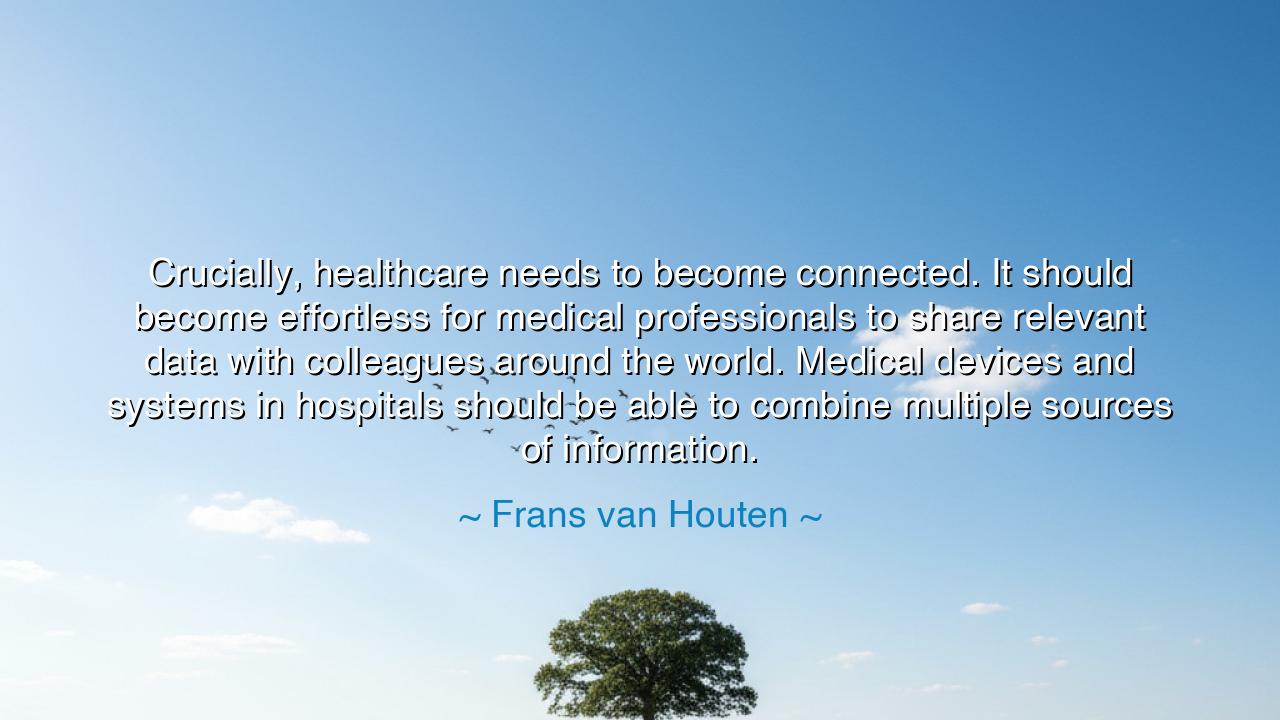
Crucially, healthcare needs to become connected. It should become
Crucially, healthcare needs to become connected. It should become effortless for medical professionals to share relevant data with colleagues around the world. Medical devices and systems in hospitals should be able to combine multiple sources of information.






The words of Frans van Houten—“Crucially, healthcare needs to become connected. It should become effortless for medical professionals to share relevant data with colleagues around the world. Medical devices and systems in hospitals should be able to combine multiple sources of information.”—resonate like a call to unity in an age of fragmentation. Though he speaks of hospitals, machines, and data, his vision reaches far deeper—to the essence of connection itself, the harmony between knowledge and compassion, between innovation and wisdom. In his statement lies a timeless truth: that healing cannot flourish in isolation, whether among people or technologies. Just as the body thrives only when its organs communicate, so must the world of medicine become a living system, bound together by shared understanding.
At the heart of van Houten’s message is the recognition that modern medicine, for all its brilliance, suffers from disconnection. In countless hospitals and clinics, vital information lies scattered—stored in separate systems, isolated in digital silos, or trapped behind barriers of bureaucracy and outdated design. A patient’s story, written in data and diagnosis, becomes fractured; one doctor holds a piece, another holds a fragment, and the wholeness of truth is lost between them. Van Houten’s plea that healthcare “become connected” is therefore not only technical—it is deeply moral. For when data does not flow, life itself is delayed, and the time that could save becomes the time that costs.
The origin of this insight lies in van Houten’s leadership at Philips, a company long devoted to merging technology with human wellbeing. He witnessed how the tools of healing—imaging devices, monitors, record systems—were often separated by design rather than joined by purpose. His vision was not to create more machines, but to create coherence among them, so that each discovery could strengthen another. He saw that the future of medicine would not be defined by a single invention, but by the connection of all inventions into one living network. Just as the ancient scholars gathered in Alexandria to share the wisdom of the known world, so too must the physicians and engineers of our age gather across borders, sharing knowledge as freely as light.
This call for connection recalls the ancient principle of sympathy—the belief, held by philosophers from Hippocrates to the Stoics, that all things in nature are interwoven. They taught that to heal one part of the body, one must understand its relation to the whole; that every ailment, no matter how small, echoes through the entire being. So it is with modern medicine. A surgeon in Tokyo, a researcher in Geneva, a nurse in Nairobi—all are threads in a single fabric of human care. If they act in isolation, their efforts remain partial; but when they share knowledge seamlessly, they form a web strong enough to lift the suffering of millions. In this sense, data sharing is not merely efficiency—it is compassion made manifest through technology.
Consider the story of the COVID-19 pandemic, a time when van Houten’s words found their truest test. In the early months of the crisis, scientists from every corner of the earth began to share genetic data, clinical observations, and treatment outcomes at a speed never before seen in human history. Laboratories that once guarded their findings opened their doors to collaboration; nations that stood apart united in purpose. This unprecedented connectedness allowed vaccines to be developed in record time, proving that when the barriers of pride and policy fall, humanity’s capacity for healing expands beyond imagination. Yet even amid this triumph, the pandemic revealed the dangers of disunity—regions without access to shared information suffered most, their hospitals crippled not by lack of compassion, but by lack of connection.
Van Houten’s vision, then, is not a distant dream but a moral imperative. He urges us to see technology not as cold machinery, but as a bridge between minds and hearts. To make healthcare “effortless” in its sharing is to restore dignity to the patient and strength to the healer. It is to free the doctor from the chains of inefficiency, to give the nurse access to every truth needed for care, to allow the scientist’s discovery to serve beyond borders. When information flows freely, healing itself flows freely—and the very nature of medicine evolves from fragmented reaction to unified foresight.
From Frans van Houten’s wisdom, we draw this eternal lesson: connection is the highest form of intelligence. Whether in medicine, art, or the governance of nations, progress arises not from isolated genius but from the harmony of many minds working as one. The heart cannot beat without the lungs, the brain cannot think without the blood; likewise, no institution or nation can heal its people without collaboration. To build connected healthcare is to honor the unity of life itself—to recognize that every patient is part of a global story, and every cure a thread in the tapestry of humanity.
So let these words endure as both guidance and challenge. Let every healer, innovator, and citizen strive to connect—to bridge not only systems but souls. For when knowledge becomes shared, when compassion becomes collective, when technology serves understanding rather than isolation, then and only then shall humanity fulfill its truest purpose: to heal together, as one living body beneath the light of a shared wisdom.






AAdministratorAdministrator
Welcome, honored guests. Please leave a comment, we will respond soon